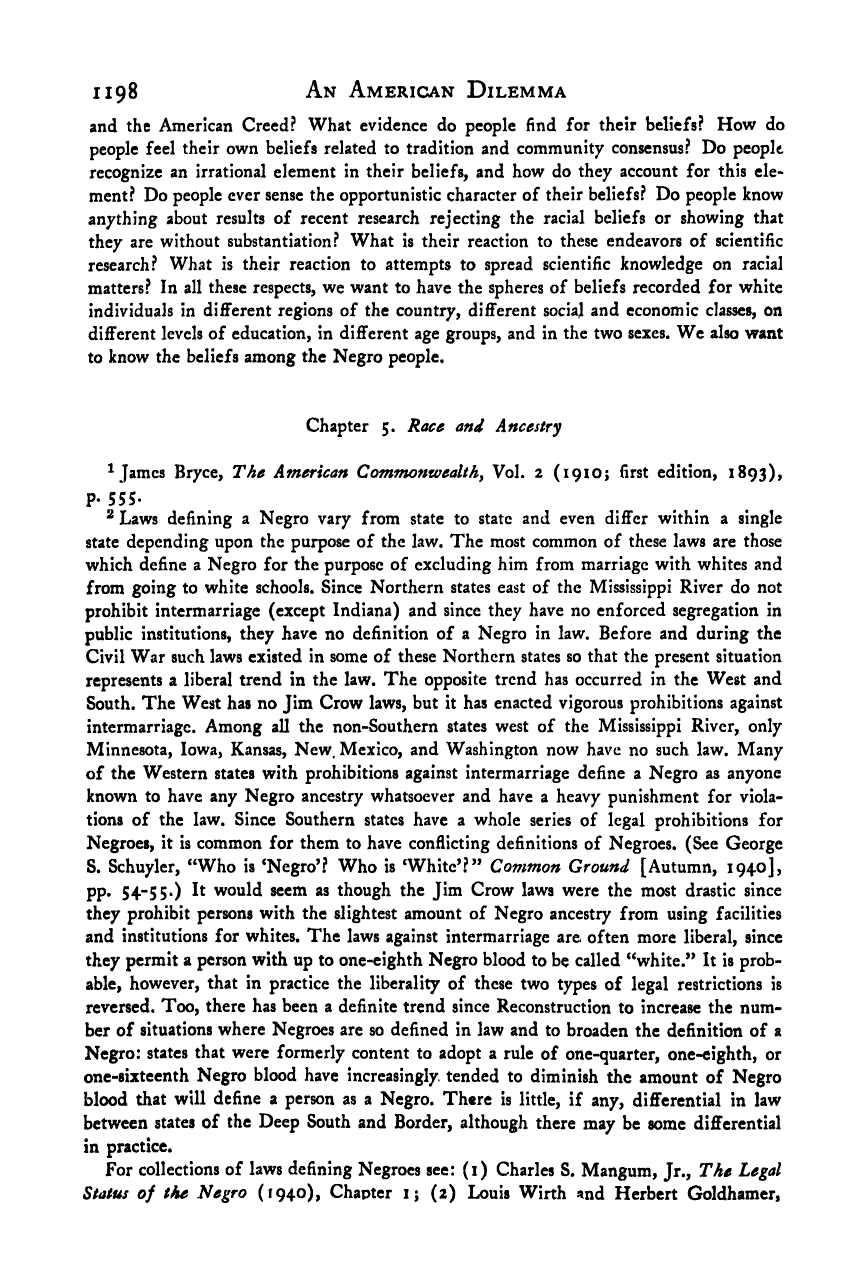Note: Gunnar Myrdal died in 1987, less than 70 years ago. Therefore, this work is protected by copyright, restricting your legal rights to reproduce it. However, you are welcome to view it on screen, as you do now. Read more about copyright.
Full resolution (TIFF) - On this page / på denna sida - Footnotes - Chapter 4 - Chapter 5

<< prev. page << föreg. sida << >> nästa sida >> next page >>
Below is the raw OCR text
from the above scanned image.
Do you see an error? Proofread the page now!
Här nedan syns maskintolkade texten från faksimilbilden ovan.
Ser du något fel? Korrekturläs sidan nu!
This page has never been proofread. / Denna sida har aldrig korrekturlästs.
1198 An American Dilemma
and the American Creed? What evidence do people find for their beliefs? How do
people feel their own beliefs related to tradition and community consensus? Do people
recognize an irrational element in their beliefs, and how do they account for this ele-
ment? Do people ever sense the opportunistic character of their beliefs? Do people know
anything about results of recent research rejecting the racial beliefs or showing that
they are without substantiation? What is their reaction to these endeavors of scientific
research? What is their reaction to attempts to spread scientific knowledge on racial
matters? In all these respects, we want to have the spheres of beliefs recorded for white
individuals in different regions of the country, different social and economic classes, on
different levels of education, in different age groups, and in the two sexes. We also want
to know the beliefs among the Negro people.
Chapter 5. Race and Ancestry
^ James Bryce, The American Commonzoealthy Vol. 2 (1910; first edition, 1893),
P- 555 -
^ Laws defining a Negro vary from state to state and even differ within a single
state depending upon the purpose of the law. The most common of these laws are those
which define a Negro for the purpose of excluding him from marriage with whites and
from going to white schools. Since Northern states east of the Mississippi River do not
prohibit intermarriage (except Indiana) and since they have no enforced segregation in
public institutions, they have no definition of a Negro in law. Before and during the
Civil War such laws existed in some of these Northern states so that the present situation
represents a liberal trend in the law. The opposite trend has occurred in the West and
South. The West has no Jim Crow laws, but it has enacted vigorous prohibitions against
intermarriage. Among all the non-Southern states west of the Mississippi River, only
Minnesota, Iowa, Kansas, New. Mexico, and Washington now have no such law. Many
of the Western states with prohibitions against intermarriage define a Negro as anyone
known to have any Negro ancestry whatsoever and have a heavy punishment for viola-
tions of the law. Since Southern states have a whole series of legal prohibitions for
Negroes, it is common for them to have conflicting definitions of Negroes, (See George
S. Schuyler, “Who is ‘Negro’? Who is ‘White’?” Common Ground [Autumn, 1940],
pp. 54-55.) It would seem as though the Jim Crow laws were the most drastic since
they prohibit persons with the slightest amount of Negro ancestry from using facilities
and institutions for whites. The laws against intermarriage are often more liberal, since
they permit a person with up to one-eighth Negro blood to be called “white.” It is prob-
able, however, that in practice the liberality of these two types of legal restrictions is
reversed. Too, there has been a definite trend since Reconstruction to increase the num-
ber of situations where Negroes are so defined in law and to broaden the definition of a
Negro: states that were formerly content to adopt a rule of one-quarter, one-eighth, or
one-sixteenth Negro blood have increasingly, tended to diminish the amount of Negro
blood that will define a person as a Negro. There is little, if any, differential in law
between states of the Deep South and Border, although there may be some differential
in practice.
For collections of laws defining Negroes see: (i) Charles S. Mangum, Jr., The Legal
Status of the Negro (1940), Chapter i; (2) Louis Wirth and Herbert Goldhamer,
<< prev. page << föreg. sida << >> nästa sida >> next page >>